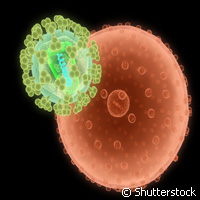Dynamics of HIV budding uncovered
It has long been established that the human immunodeficiency virus (HIV) invades human immune cells and causes them to produce new copies of the virus, which in turn infects new cells. But the order of events, their kinetics and actions of individual components in HIV budding still remain unclear. However, a new study from an international team of researchers has cast the net on the role of the enzyme VPS4A, revealing that it plays a more active part in the whole process than was previously thought. VPS4A was already known to act after virus budding is complete, but thanks to an advanced microscopy technique, the researchers were able to show that complexes containing about a dozen VPS4A molecules form at points in the membrane where newly assembled virions later emerge. Professor Lamb, one of the lead researchers from Ludwig-Maximilians-Universitaet (LMU) in Munich, Germany said: 'We can now demonstrate in detail, for the first time, how host proteins interact with components of HIV, to enable them to bud from infected cells. With the methods we have at our disposal, we can also study the effects of drugs on infected cells, which may allow us to improve their efficacy or even lead to the development of new classes of active compounds.' A virus alters the course of a cell in accordance with its own purpose; once a virus's own genetic material has entered a host cell, the host cell becomes reprogrammed and produces new virus particles. To release these new viruses, HIV exploits cellular proteins involved in the loading, sorting and budding of cellular vesicles known as ESCRT proteins. During budding, HIV makes use of ESCRT to cut the last connection between the virion coat and the cell surface, allowing it to exit the cell. The enzyme VPS4A forms part of the ESCRT machinery and is known to be necessary for the disassembly of the complex after use, allowing its components to be recycled. The findings uncover that VPS4A acts at an earlier stage in the budding process. The researchers were able to track and trace the enzyme using ultrasensitive live-cell imaging experiments. They were able to watch the enzyme and elucidate the dynamics of HIV budding after fusing it with green fluorescent protein - effectively a microscopic highlighter. Complexes made up of about three dodecamers (a protein complex with 12 protein subunits) of VPS4A were found to undergo transient activation at a budding site. Shortly afterwards, the virions were observed to emerge from the cell at these locations. Because virion release does not follow immediately upon activation of the enzyme, the investigators believe that at least one further intermediate step is required for budding. These results indicate that VPS4A has a direct role in membrane scission leading to HIV-1 release. 'Our current methodology allows us to monitor the assembly of individual virions, and we are working on further refinements that will allow us to follow the complete life cycle of HIV,' says Professor Lamb. 'We can already visualise some steps of the life cycle at the level of a single virus, observe interactions and determine the kinetics of different processes.' HIV infection in humans was discovered in 1981 and has since killed millions of people worldwide. The four major routes of transmission are unsafe sex, contaminated needles, breast milk, and transmission from an infected mother to her baby at birth. Thanks to blood product screening, the transmission of HIV through blood transfusion has largely been eradicated in the developed world. Figures from the World Health Organisation's 2009 Global Report showed that 33.3 million people worldwide were living with HIV at the time, and that 2.6 million people were newly affected that year. This research goes some way to shedding light on the whole process of HIV, and ultimately finding a cure for HIV/AIDS, a sentiment echoed by Professor Lamb: 'Our ultimate goal is to elucidate the entire life cycle of the virus.'For more information, please visit: LMU Munich:http://www.en.uni-muenchen.de/index.htmlNature Cell Biologyhttp://www.nature.com/ncb/index.html
Countries
Germany



